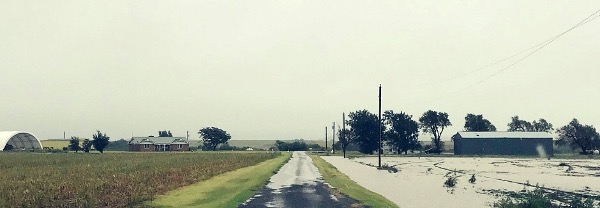Oklahoma Conservation deeply rooted and getting stronger according to U.S. Census of Agriculture
The recently released 2017 U.S. Census of Agriculture detailed in part that less and less of Oklahoma’s soil is whisked away by its powerful winds.
A good anchor will do that.
“The Oklahoma Conservation Commission (OCC) and local Districts felt sure the actual findings of the Census would show that the roots of conservation in Oklahoma are strengthening. The report did that and so much more,” said Trey Lam, executive director of the Oklahoma Conservation Commission. “The hundreds of field days, demonstration farms and educational events created even more change in no till and cover crop adoption rates than we expected. Oklahoma farmers and ranchers ‘get it.’ By adopting a system that protects and restores the productivity of our soil they can improve their bottom line and leave their land in better shape for generations to come.”

Anticipating the release of the Ag Census information was reminiscent of report card day back in school. Oklahoma farmers and ranchers in cooperation with the Conservation Partnership had put in the time and hard work to increase Soil Health practices. The Ag Census is the report card on whether all that work paid dividends.
Lam, along with others such as Natural Resources Conservation Service (NRCS) State Conservationist Gary O’Neill, are excited to share that report card.
The 2017 U.S. Census of Agriculture – released by the United States Department of Agriculture’s (USDA) National Agricultural Statistics Service (NASS) – showed that in Oklahoma, compared to 2012, there was a 24 percent increase in the number of farms using cover crops, a 51 percent increase in acres using cover crops, and a 29 percent decrease in intensive tillage practices. On a national scale, the report shows that Oklahoma is seventh in the nation for the largest decrease in cropland acreage using conventional tillage practices.
O’Neill said, “Reduced tillage and cover crops are two of the primary principles of Soil Health systems. These data trends show that Oklahoma farmers and ranchers are recognizing the benefits from implementing Soil Health Systems on their lands.”
Jimmy Emmons of Leedey, along with wife Ginger, received Oklahoma’s first Leopold Conservation Award in 2018. The award recognizes extraordinary achievement in voluntary conservation by American ranchers, farmers and foresters. Jimmy Emmons also waited anxiously for the release of the report.
“I was expecting the no till and cover cropping numbers to be up, but not that much,” he said. “Less tillage is a wonderful number. The report is so exciting because it shows all the hard work we have done promoting no till and covers is working.”
The Census of Agriculture is a complete count of U.S. farms and ranches and the people who operate them. Even small plots of land – whether rural or urban – growing fruit, vegetables or some food animals count if $1,000 or more of such products were raised and sold, or normally would have been sold, during the Census year. The Census of Agriculture, taken only once every five years, looks at land use and ownership, operator characteristics, production practices, income and expenditures.
The Census of Agriculture provides the only source of uniform, comprehensive, and impartial agriculture data for every county in the nation. Through the Census of Agriculture, producers can show the nation the value and importance of agriculture and can influence decisions that will shape the future of U.S. agriculture.
“I definitely think this shows that Oklahoma has embraced conservation and is a true partner with a lot of the organizations around the state that are putting conservation on the ground within the Ag community,” said Troy Marshall, the Oklahoma State Statistician for USDA NASS.
Most report cards leave a little room to build on. While statistics improved in cropland with reduced till practices and in cropland with intensive till practices, there was a decrease in cropland with no-till practices, and Emmons said “hopefully (that) will change as people understand cover cropping.”
Lam believes the root system of conservation in Oklahoma will only continue to strengthen.
“The pace of change should only increase from this point forward,” Lam said. “The momentum created over the last few years by NRCS and OCC programs make the future bright for natural resource conservation in our state.”
